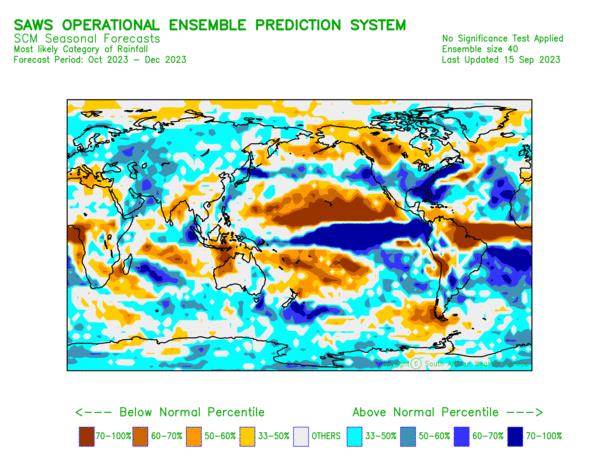NATIONAL NEWS - The El Niño-Southern Oscillation (ENSO) is currently in an El Niño state and according to the latest predictions is expected to persist through most of the summer months. ENSO’s typical impact on Southern Africa is in favour for generally drier and warmer conditions during the summer seasons from October to March. However, current global forecasts indicate a great deal of uncertainty for the typical drier conditions that South Africa experiences during typical El Niño seasons.
The South African Weather Service (SAWS) multi-model rainfall forecast indicates above-normal rainfall for large parts of the country during the Oct-Nov-Dec season, though mostly with low probabilities of above-normal rainfall.
Below-normal rainfall is expected during the Nov-Dec-Jan and Dec-Jan-Feb) seasons over the western and central parts of the country, with the highest probabilities of below-normal rainfall over the far-western parts of the country. Predictions still favour above-normal rainfall conditions over the north-eastern parts of the country, even with an El Niño in place. Caution is advised at this point as the El Niño effect might still manifest its influence in the next few months and change the outlook of the rainfall forecast for mid- and late-summer.
Minimum and maximum temperatures are expected to be mostly above-normal countrywide for the forecast period.
The SAWS will continue to monitor the weather and climate conditions and provide updates on any future assessments that may provide more clarity on the current expectations for the coming season.
South African Weather Service Prediction System
Ocean-Atmosphere Global Climate Model
The SAWS is currently recognised by the World Meteorological Organization (WMO) as a Global Producing Centre (GPC) for Long-Range Forecasts (LRF). This is owing to its local numerical modelling efforts, which involve coupling of both the atmosphere and ocean components to form a fully interactive coupled modelling system, named the SAWS Coupled Model (SCM), the first of its kind in both South Africa and the region. Below are the first season (October-November-December) predictions for rainfall (Figure 1) and average temperature (Figure 2).
 Figure 1: October-November-December, OND (2023) global prediction for total rainfall probabilities.
Figure 1: October-November-December, OND (2023) global prediction for total rainfall probabilities.
 Figure 2: October-November-December, OND (2023) global prediction for average temperature probabilities.
Figure 2: October-November-December, OND (2023) global prediction for average temperature probabilities.
Summary implications to various economic sector decision makers:
Water and Energy
The above-normal rainfall expected during Oct-Nov-Dec season is likely to benefit water reservoirs in regions classified as summer rainfall areas. There is a possibility of water loss through evapotranspiration and other processes in the south-western and central parts of the country, where mostly below-normal rainfall and above-normal minimum and maximum temperatures are expected. In addition, the expected above-normal minimum and maximum temperatures during the forecast period would likely increase the demand for cooling.
Relevant decision-makers are encouraged to take note of these possible outcomes and communicate to affected businesses and communities.
Health
The predicted above-normal rainfall during the Oct-Nov-Dec season across the country and during Nov-Dec-Jan and Dec-Jan-Feb in the north-eastern parts of the country, might lead to flooding, particularly in flood-prone areas, leading to immediate health impacts such as drowning, injuries, hypothermia, animal and mosquito bites as well as increased risks of water-related and vector-borne diseases.
The predicted above-normal minimum and maximum temperatures throughout the forecasting period, except for some small parts of the Northern Cape, would likely lead to warm conditions with minimum health implications, however, based on the World Health Organization (WHO) and World Meteorological Organization (WMO) ultraviolet radiation (UV) universal standard, UV levels which are higher than 3, are at an exposure category where sun protection is required in a form of seeking of shade, wearing of appropriate clothing that covers the body and application of sunscreen, mostly during midday hours.
It is crucial for the public to heed essential precautions and diligently adhere to the guidelines and recommendations issued by local authorities.
Agriculture
The rainfall forecasts indicate above-normal rainfall over the northern and north-eastern parts of the country during the late-spring and summer seasons. These above-normal rainfall forecasts would likely have a positive impact on crop and livestock production.
However, below-normal rainfall is predicted over most parts of the central and south-western areas of the country during early and late-summer seasons. Therefore, the relevant decision-makers are encouraged to advise farmers in these regions to practice soil and water conservation, proper water harvesting and storage, establishing good drainage systems, and other appropriate farming practices.
This forecast is updated monthly, and users are advised to monitor the updated forecasts, as there is a possibility for them to change, especially the longer lead-time forecasts. Moreover, farmers are advised to keep monitoring the weekly and monthly forecasts issued by the SAWS). Farmers are also advised to keep on monitoring advisories from the Department of Agriculture and make changes as required.
Click below to read the full report:
Seasonal Climate Watch report for the period October 2023 to February 2024
‘We bring you the latest Garden Route, Hessequa, Karoo news’















